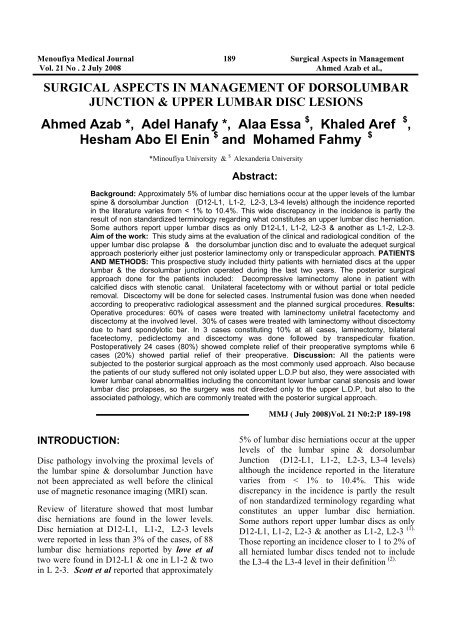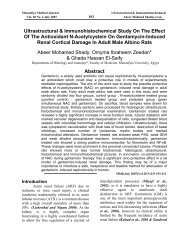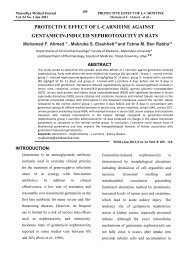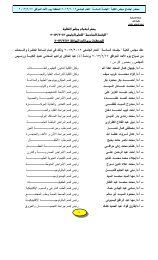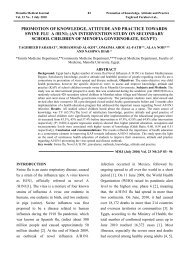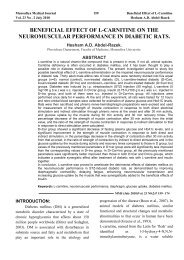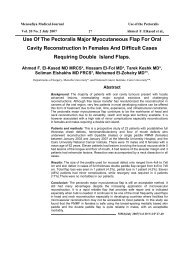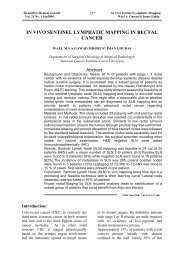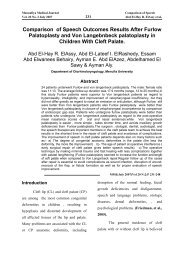Ahmed Azab *, Adel Hanafy *, Alaa Essa, Khaled Aref, Hesham ...
Ahmed Azab *, Adel Hanafy *, Alaa Essa, Khaled Aref, Hesham ...
Ahmed Azab *, Adel Hanafy *, Alaa Essa, Khaled Aref, Hesham ...
You also want an ePaper? Increase the reach of your titles
YUMPU automatically turns print PDFs into web optimized ePapers that Google loves.
Menoufiya Medical Journal 189 Surgical Aspects in Management<br />
Vol. 21 No . 2 July 2008 <strong>Ahmed</strong> <strong>Azab</strong> et al.,<br />
SURGICAL ASPECTS IN MANAGEMENT OF DORSOLUMBAR<br />
JUNCTION & UPPER LUMBAR DISC LESIONS<br />
<strong>Ahmed</strong> <strong>Azab</strong> *, <strong>Adel</strong> <strong>Hanafy</strong> *, <strong>Alaa</strong> <strong>Essa</strong> $ , <strong>Khaled</strong> <strong>Aref</strong> $ ,<br />
<strong>Hesham</strong> Abo El Enin $ and Mohamed Fahmy $<br />
INTRODUCTION:<br />
*Minoufiya University & $ Alexanderia University<br />
Abstract:<br />
Background: Approximately 5% of lumbar disc herniations occur at the upper levels of the lumbar<br />
spine & dorsolumbar Junction (D12-L1, L1-2, L2-3, L3-4 levels) although the incidence reported<br />
in the literature varies from < 1% to 10.4%. This wide discrepancy in the incidence is partly the<br />
result of non standardized terminology regarding what constitutes an upper lumbar disc herniation.<br />
Some authors report upper lumbar discs as only D12-L1, L1-2, L2-3 & another as L1-2, L2-3.<br />
Aim of the work: This study aims at the evaluation of the clinical and radiological condition of the<br />
upper lumbar disc prolapse & the dorsolumbar junction disc and to evaluate the adequet surgical<br />
approach posteriorly either just posterior laminectomy only or transpedicular approach. PATIENTS<br />
AND METHODS: This prospective study included thirty patients with herniated discs at the upper<br />
lumbar & the dorsolumbar junction operated during the last two years. The posterior surgical<br />
approach done for the patients included: Decompressive laminectomy alone in patient with<br />
calcified discs with stenotic canal. Unilateral facetectomy with or without partial or total pedicle<br />
removal. Discectomy will be done for selected cases. Instrumental fusion was done when needed<br />
according to preoperativc radiological assessment and the planned surgical procedures. Results:<br />
Operative procedures: 60% of cases were treated with laminectomy uniletral facetectomy and<br />
discectomy at the involved level. 30% of cases were treated with laminectomy without discectomy<br />
due to hard spondylotic bar. In 3 cases constituting 10% at all cases, laminectomy, bilateral<br />
facetectomy, pediclectomy and discectomy was done followed by transpedicular fixation.<br />
Postoperatively 24 cases (80%) showed complete relief of their preoperative symptoms while 6<br />
cases (20%) showed partial relief of their preoperative. Discussion: All the patients were<br />
subjected to the posterior surgical approach as the most commonly used approach. Also because<br />
the patients of our study suffered not only isolated upper L.D.P but also, they were associated with<br />
lower lumbar canal abnormalities including the concomitant lower lumbar canal stenosis and lower<br />
lumbar disc prolapses, so the surgery was not directed only to the upper L.D.P, but also to the<br />
associated pathology, which are commonly treated with the posterior surgical approach.<br />
Disc pathology involving the proximal levels of<br />
the lumbar spine & dorsolumbar Junction have<br />
not been appreciated as well before the clinical<br />
use of magnetic resonance imaging (MRI) scan.<br />
Review of literature showed that most lumbar<br />
disc herniations are found in the lower levels.<br />
Disc herniation at D12-L1, L1-2, L2-3 levels<br />
were reported in less than 3% of the cases, of 88<br />
lumbar disc herniations reported by love et al<br />
two were found in D12-L1 & one in L1-2 & two<br />
in L 2-3. Scott et al reported that approximately<br />
MMJ ( July 2008)Vol. 21 N0:2:P 189-198<br />
5% of lumbar disc herniations occur at the upper<br />
levels of the lumbar spine & dorsolumbar<br />
Junction (D12-L1, L1-2, L2-3, L3-4 levels)<br />
although the incidence reported in the literature<br />
varies from < 1% to 10.4%. This wide<br />
discrepancy in the incidence is partly the result<br />
of non standardized terminology regarding what<br />
constitutes an upper lumbar disc herniation.<br />
Some authors report upper lumbar discs as only<br />
D12-L1, L1-2, L2-3 & another as L1-2, L2-3 (1).<br />
Those reporting an incidence closer to 1 to 2% of<br />
all herniated lumbar discs tended not to include<br />
the L3-4 the L3-4 level in their definition (2).
Menoufiya Medical Journal 190 Surgical Aspects in Management<br />
Vol. 21 No . 2 July 2008 <strong>Ahmed</strong> <strong>Azab</strong> et al.,<br />
The clinical presentation of disc proloapse at the<br />
level of upper lumbar spine & dorsolumbar<br />
Junction varies from; Low back pain which is<br />
usually dull aching pain , may be sever and<br />
causing abdominal pain. Pain exacerbates with<br />
coughing or valsalva maneuver as it increases the<br />
intra thecal pressure, Radicular pain in the<br />
dermatomal sensory distribution at the<br />
compressed root can be the only pain or<br />
associated with low back pain, Cauda equine<br />
compression syndrome due to central mechanical<br />
compression of the cauda equina, Neurogenic<br />
claudications as limited walking tolerance, back<br />
pain, much like patients with lower lumbar canal<br />
stenosis, Myelopathic manifestations,<br />
myelopathy with long tract signs, gait<br />
disturbance, weakness or spasticity, Conus<br />
medullaries compression resulting in paraparesis<br />
& even paraplegia with bowel & bladder<br />
dysfunction (3).<br />
Diagnostic investigations is very important for<br />
surgical decision such as plain radiography<br />
which can indirectly suggest pathology such as<br />
decreased disc space. The CT scan is one of the<br />
imaging modalities used for diagnosis of<br />
herniated lumbar disc in addition to its<br />
important role in detection of spinal canal<br />
stenosis. MRI gives excellent visualization of<br />
root anatomy, disc herniation and fragments<br />
including foraminal and far lateral pathologies (4).<br />
AIM OF THE WORK:<br />
This study aims at the evaluation of the clinical<br />
and radiological condition of the upper lumbar<br />
disc prolapse & the dorsolumbar junction disc<br />
and to evaluate the adequet surgical approach<br />
posteriorly either just posterior laminectomy<br />
only or transpedicular approach.<br />
PATIENTS AND METHODS:<br />
This prospective study included thirty patients<br />
with herniated discs at the upper lumbar & the<br />
dorsolumbar junction operated during the last<br />
two years. All patients were subjected to the<br />
following:<br />
Complete history including the inquirements<br />
about the age, sex, the onset, duration and nature<br />
of the complaints, the history of previous<br />
operations, also any associated diseases in<br />
addition to inquirement about available<br />
radiological investigations.<br />
General examination To assess the conditions<br />
of the chest, heart, abdomen and lower limbs,<br />
which is important to determine whether the<br />
patient is fit for surgery or not.<br />
Neurological examination including: Evaluation<br />
of patient's gait. Back examination for<br />
paravertebral spasm, limitation of movement, the<br />
lumbosacral angle and curve, any tenderness in<br />
the back and scar of any previous operations.<br />
Femoral stretch test is tested in both lower limbs.<br />
Straight leg raising test is tested in both lower<br />
limbs and its angle is recorded. Reflex changes is<br />
examined and recording any absence or<br />
diminution. Testing any dermatomal loss.<br />
Routine laboratory investigations including:<br />
Complete blood count. Liver function tests.<br />
Renal function tests. Bleeding and coagulation<br />
profile. Random blood sugar.<br />
Radiological investigations including: Plain X<br />
rays of the dorsolumbar and lumbosacral spine<br />
with Anteroposterior and lateral films, Stress<br />
films, Oblique films. MRI of the dorsolumbar<br />
and lumbosacral spine. CT scan was available<br />
with 50% of the patients on admission.<br />
The clinical indications for surgery were:<br />
Progressive neurological deficits. Pain not<br />
responding to conservative measures.<br />
The posterior surgical approach done for the<br />
patients included:<br />
The patient is under general anesthesia in a<br />
prone position. Midline back incision and<br />
incision of the fascia and then retraction of the<br />
muscles. Intraoperative fluoroscopy used when<br />
needed for levelling. Decompressive<br />
laminectomy alone in patient with calcified discs<br />
with stenotic canal. Unilateral facetectomy with<br />
or without partial or total pedicle removal.
Menoufiya Medical Journal 191 Surgical Aspects in Management<br />
Vol. 21 No . 2 July 2008 <strong>Ahmed</strong> <strong>Azab</strong> et al.,<br />
Discectomy will be done for selected cases.<br />
Instrumental fusion was done when needed<br />
according to preoperativc radiological<br />
assessment and the planned surgical procedures.<br />
Postoperative follow up clinically and<br />
radiographically;<br />
Clinically; as regard the improvement of<br />
symptoms and signs and occurrence of<br />
complications including neurological deficits and<br />
infection.<br />
Picture( 1 ) MRI LSS showing D12-L1disc prolapse<br />
Picture( 2 ) MRI LSS showing L1-L2 disc prolapse<br />
Radiologically; by pain X-ray films of<br />
dorsolumbar and lumbosacral spine at one month<br />
and 6 months postoperatively to assess the<br />
development of segmental instability.<br />
Postoperative MRI L.S.S will be done when<br />
needed if patient deteriorated postoperatively.
Menoufiya Medical Journal 192 Surgical Aspects in Management<br />
Vol. 21 No . 2 July 2008 <strong>Ahmed</strong> <strong>Azab</strong> et al.,<br />
Picture( 3 ) MRI LSS showing L2-L3 disc prolapse.<br />
Picture(4) Post operative Plain x ray LSS after L2-L3 discectomy & fixation
Menoufiya Medical Journal 193 Surgical Aspects in Management<br />
Vol. 21 No . 2 July 2008 <strong>Ahmed</strong> <strong>Azab</strong> et al.,<br />
RESULTS:<br />
Table (I): Sex distribution: Males were more affected than females. Males (80%), females (20%).<br />
Gender No. of patients Percentage<br />
Males 24 80%<br />
Females 6 20%<br />
Total 30 100%<br />
Table (2): Age distribution: Most of patients affected were in the age group from 40-49 ys.<br />
Age group (years) No. of patients Percentage<br />
20-29 1 3.3%<br />
30-39 9 30%<br />
40-49 12 40%<br />
50-59 7 23.3%<br />
60-69 1 3.3%<br />
Total 30 100%
Menoufiya Medical Journal 194 Surgical Aspects in Management<br />
Vol. 21 No . 2 July 2008 <strong>Ahmed</strong> <strong>Azab</strong> et al.,<br />
Table (3): Clinical picture: Low back pain was the main complaint followed by the crural and<br />
anterior thigh pain. The most dominant clinical sign was the positive femoral stretch test (70%),<br />
followed by motor weakness in (60%). The straight leg raising test (SLRT) was positive in 30%<br />
only with concomitant lower lumber disc affection:<br />
Symptoms No. of patients Percentage<br />
Low back pain (L.B.P) 30 100%<br />
Anterior thigh pain 27 90%<br />
Sensory changes 15 50%<br />
Claudication 12 40%<br />
Sphincteric disturbances 3 10%<br />
Signs<br />
Back signs 15 50%<br />
Positive femoral stretch test 21 70%<br />
Positive SLRT 9 30%<br />
Reflex changes 18 60%<br />
Sensory changes 15 50%<br />
Motor weakness 18 60%<br />
Table (4): The level of disc prolapse, the most frequent level affected was the L2-3 level,<br />
followed by Ll-2 level and lastly D12-L1 level.<br />
Level No of patients Percentage<br />
D12-L1 3 10%<br />
L1-L2 9 30%<br />
L2-L3 18 60%<br />
Total 30 100%
Menoufiya Medical Journal 195 Surgical Aspects in Management<br />
Vol. 21 No . 2 July 2008 <strong>Ahmed</strong> <strong>Azab</strong> et al.,<br />
Table(5): MRI and CT findings:<br />
MRI and CT findings No. of patients Percentage<br />
Diffuse annulus disc bulge 24 80%<br />
Central hard disc protrusion 6 20%<br />
Indentation ofthecal sac 30 100%<br />
Encroachment on lateral recess and nerve root exit<br />
foraminae<br />
24 80%<br />
Caudal migration of disc prolapse 3 10%<br />
Lumbar spondylo degenerative changes 18 60%<br />
Concomitant lower lumbar disc prolapse 9 30%<br />
Concomitant lower lumbar canal stenosis 18 60%<br />
Sagittal stenosis 18 60%<br />
Table (6) Operative procedures: 60% of cases were treated with laminectomy uniletral<br />
facetectomy and discectomy at the involved level. 30% of cases were treated with laminectomy<br />
without discectomy due to hard spondylotic bar. In 3 cases constituting 10% at all cases,<br />
laminectomy, bilateral facetectomy, pediclectomy and discectomy was done followed by<br />
transpedicular fixation.<br />
Operative procedures<br />
No. of<br />
patients<br />
Percentage<br />
Laminectomy without discectomy at involved level. 9 30%<br />
Laminectomy, unilateral facetectomy with discectomy at<br />
involved level<br />
Laminectomy, bilateral facetectomy with pediclectomy<br />
discectomy and transpedicular fixation.<br />
18 60%<br />
3 10%
Menoufiya Medical Journal 196 Surgical Aspects in Management<br />
Vol. 21 No . 2 July 2008 <strong>Ahmed</strong> <strong>Azab</strong> et al.,<br />
Table (7) Complications: One patient was complicated with dural tear and developed<br />
postoperative C.S.F. leakage. One patient developed post operative spondylodiscitis. One<br />
patient developed cauda equina syndrome due to post operative haematoma<br />
Complications No. of patients Percentage<br />
C.S.F. leakage 1 3.3%<br />
Spndylodiscitis 1 3.3%<br />
Cauda equine syndrome 1 3.3%<br />
Table (8) Operative outcome: Postoperatively 24 cases (80%) showed complete relief of their<br />
preoperative symptoms while 6 cases (20%) showed partial relief of their preoperative.<br />
Postoperative sequel No. of patients Percentage<br />
Complete relief 24 80%<br />
Partial relief 6 20%<br />
DISCUSSION:<br />
Approximately 5% of lumbar disc herniations<br />
occur at upper levels of the lumbar spine (L1-<br />
2,L2-3,L3-4), although the incidence reported in<br />
the literature varies from < l-10.4% (5 ' 6 ' 7) This<br />
wide discrepancy in incidence is partly the result<br />
of non standardized terminology regarding what<br />
constitutes an "upper" lumbar disc herniation -<br />
some authors report upper lumbar discs as only<br />
L1-2and L2-3 (1) . Those reporting an incidence<br />
closer to 1-2% of all herniated lumbar discs did<br />
not include the L3-4 level in their definition (2).<br />
In the present study, the disc herniation at the<br />
level of L3-4 was not included among our cases<br />
of upper lumbar disc herniations, so the disc<br />
prolapses at D12-L1, L1-2 and L2-3 were the<br />
target of the present study.<br />
Similarly, Scott P. Sanderson et al in 2004, in<br />
their study about the unique characteristics of<br />
upper lumbar disc herniations, reported that disc<br />
herniations at L3-4 are different in their patient<br />
population and surgical outcome from those at<br />
L1-2 and L2-3 levels, and also reported that disc<br />
herniations at L3-4 are more similar to those<br />
occurring at L4-5 and L5-S1in their surgical<br />
outcome and patient population (8).<br />
The lower incidence of upper L.D.P. may be<br />
attributed to the decreased motion of the upper<br />
lumbar spine compared with the lower lumbar<br />
spine that may lead to less spondylosis, less disc<br />
degeneration and thus fewer herniated discs (9).<br />
In the present study, the MRI of L.S.S. was<br />
regarded as the most important and main<br />
investigation done for all patients and surgery<br />
was decided up on it.<br />
Similarly, Albert et al in 1993, recommended the<br />
MRI as the main diagnostic tool in the work-up<br />
of patients with upper L.D.P (10) Also, Mark<br />
Weidenbaum et al in 2002 reported that MRI has<br />
become the imaging procedure of choice in
Menoufiya Medical Journal 197 Surgical Aspects in Management<br />
Vol. 21 No . 2 July 2008 <strong>Ahmed</strong> <strong>Azab</strong> et al.,<br />
evaluating disc pathology, neural structures and<br />
muscloligamentous components and also gives<br />
excellent visualization of root anatomy, disc<br />
herniation and other conditions that may mimic it<br />
such as synovial cyst, neurofibroma or perineural<br />
cyst (11).<br />
All the patients were subjected to the posterior<br />
surgical approach as the most commonly used<br />
approach. Also because the patients of our study<br />
suffered not only isolated upper L.D.P but also,<br />
they were associated with lower lumbar canal<br />
abnormalities including the concomitant lower<br />
lumbar canal stenosis and lower lumbar disc<br />
prolapses, so the surgery was not directed only to<br />
the upper L.D.P, but also to the associated<br />
pathology, which are commonly treated with the<br />
posterior surgical approach. Intraoperatively, in<br />
18 cases constituting (60%), there was a soft disc<br />
bulge encroaching upon the nerve root exit<br />
foramine, while in 3 cases constituting (10%)<br />
there was a sequestrated disc prolpase with<br />
unilateral encroachment on the nerve root exit<br />
foramina. But in 9 cases constituting 30% of all<br />
cases in the present study, there was a hard<br />
spondylotic bar with a lateral recess stenosis and<br />
so, the surgical procedure done for this group<br />
was just a laminectomy and foraminotomy at the<br />
involved level without discectomy. While in 18<br />
cases constituting 60% of all cases in the present<br />
study were subjected to laminectomy (including<br />
formal and hemilaminectomy) unilateral<br />
facetectomy and discectomy at the involved<br />
level. Three cases with disc prolapses at D12-L1<br />
had an additional surgical procedures aiming to<br />
gain a lateral access to the disc prolapse with<br />
avoidance of manipulation to mobilize the<br />
sensitive neural structures at the upper lumbar<br />
levels including the conus medullaris and cauda<br />
equina. These additional surgical procedures<br />
included bilateral facetectomy with pedicle<br />
removal which necessitated an additional<br />
transpedicular fixation of one level above and<br />
one level below the involved level with<br />
instrumentation to avoid the late instability. So,<br />
the instrumental fusion was done for these<br />
patient depending only on one indication that<br />
was the extensive facetectomy to avoid the late<br />
instability.<br />
However, Scott P. Sanderson et al in 2004 in his<br />
retrospective study about patients with upper<br />
L.D.P, he mentioned that the fusion in patients<br />
with upper L.D.P treated surgically was done if<br />
the patient had incapacitating back pain, had<br />
preexisting spondylolisthesis or required such<br />
extensive facet removal to access the disc that<br />
predisposed the patient to instability (8).<br />
In addition, to the surgical intervention at the<br />
involved level, patients who suffered<br />
concomitant lower lumbar canal stenosis were<br />
subjected to decompressive laminectomy at<br />
lower lumbar levels, those patients were 18 cases<br />
constituting 60% of all cases of the present<br />
study. While patients who suffered concomitant<br />
disc herniation at lower lumbar level were 9<br />
cases: 5 cases of them were associated with disc<br />
prolapse at L4/5 level while 2 cases were<br />
associated with disc prolapse at L3/4 level and<br />
another two cases at L5/S1 level, and those<br />
patients were subjected to concomitant surgical<br />
intervention at the affected level in the form of<br />
laminectomy and discectomy in addition to<br />
surgical intervention at the upper lumbar disc<br />
prolapse.<br />
Regarding the postoperative sequelae of the<br />
patients operated in the present study, 24 patients<br />
(80%) showed complete relief of symptoms<br />
postoperatively, while 20% of patients showed<br />
partial relief of their complaints and those<br />
patients were found to have significant<br />
neurological deficits preoperatively mainly the<br />
motor weakness and sphincteric disturbances.<br />
Among this group of patients that showed partial<br />
relief of symptoms postoperatively, one patient<br />
was complicated with unintended durotomy<br />
intraoperatively and developed C.S.F. leak<br />
postoperatively which was managed in the ward<br />
conservatively till the leakage stopped and<br />
patient was discharged with relief of preoperative<br />
symptoms. Another patient developed<br />
postoperative spondylodiscitis and was treated<br />
with conservative measure and showed relief of<br />
preoperative symptoms after a period of one
Menoufiya Medical Journal 198 Surgical Aspects in Management<br />
Vol. 21 No . 2 July 2008 <strong>Ahmed</strong> <strong>Azab</strong> et al.,<br />
month. One patient was complicated with cauda<br />
equina syndrome postoperatively, MRI was done<br />
that showed postoperative extradural hematoma<br />
compressing the thecal sac, this patient needed<br />
another immediate intervention for evacuation of<br />
the hematoma and showed rapid recovery<br />
immediately after evacuation of the hematoma.<br />
REFERENCES<br />
1- Su H, Zucherman J, Shea W. High lumbar<br />
disc herniation, incidence and etiology. Spine.<br />
1990;15:679-82.<br />
2- Bosacco Sj, Berman AT, Raisis LW,<br />
Zamarin RI. High lumbar disc herniation case<br />
reports. Orthopedics. 1989;12:275-8.<br />
3-Lee DY, Kim HS, Lee SH. Multi access for<br />
diagnosis of missed upper lumbar disc<br />
herniation. J Korean Neurosurgery Soc.<br />
2005;38:144-6.<br />
4- Abrishamkar S, Mansour BA, Arti H. The<br />
effectiveness of computed tomography scans<br />
versus magnetic resonance imaging for decision<br />
making in patients with low back pain and<br />
radicular leg pain. Journal of Reserch in Medical<br />
Sciences. Nov & Dec 2006;11 (6):351-4.<br />
5- Aronson HA, Dunsmore RH. Herniated<br />
lumbar discs. J Bone Joint Surg.1993;45-A:311-7.<br />
6- Greenberg M et al. Lumbar spoinal stenosis,<br />
Handbook of Neurosurgery. 6 th ed. New York:<br />
Thieme;2006;289-369.<br />
7- Albert TJ, Baiderston RA, Heller JG,<br />
Herkowitz HN, Garfin SR, Tomany K, et al.<br />
Upper lumbar disc herniations. J Spinal Disord.<br />
1993;6:351-9.<br />
8- Sanderson SP, Houten J, Errico T,<br />
Forshaw D, Bauman J, Cooper PR. The<br />
unique characteristics of upper lumbar disc<br />
herniation. Neurosurgery. 2004; 55:385-9.<br />
9- Fontnesi G, Tartalgia I, Cavazutti A,<br />
Giancecchi F. Prolapse intervertebral disc at the<br />
upper lumbar level. Ital J Ortop Traumatol.<br />
1987;13:501-7.<br />
10- Albert TJ, Baiderston RA,Heller JG,<br />
Herkowitz HN, Garfin SR, Tomany K, et al.<br />
Upper lumbar disc herniations. J Spinal Disord.<br />
1993; 6:351-9.<br />
11- Weidenbaum M. Lumbar disc herniation<br />
and radiculopathy. In: Frymoyer JW, editor.<br />
Adult and pediatric Spine. 3 rd ed. Philadelphia:<br />
Lipincott- Williams and Willikins; 2004;19:920.


